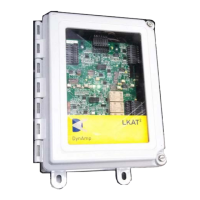Installation, Operation and Service Manual LKAT
2
Portable
© 2018 DynAmp, LLC Page 25
047312 A
Generally, system calibration compares the output of the device under test (“DUT”) to a
reference.
The best calibration method is to return LKAT
2
Systems to the factory for calibration on a
test bus in a very controlled environment with extremely stable and accurately measured
current. This requires that the LKAT
2
Measuring Head be removed from process bus. The
head and associated Metering Unit must be returned together, and should have the same
serial number. The signal output and input power cable assemblies do not need to be
returned for factory calibration. Specific details of factory calibration are beyond the scope
of this manual.
Field calibration is possible using a 0.1% accurate current measurement system, such as
the DynAmp LKP, LKCO or Opti-Cal as a reference. Due to significantly larger size and
mass, it may be difficult to install a comparably rated LKP Measuring Head in on the same
bus as the LKAT
2
. An existing LKCO or DynAmp’s portable Opti-Cal system is better suited
for this purpose.
Field calibration accuracy depends on the stability of the test bus current, the accuracy of
the reference current measurement system and ammeters, as well as the linearity of the
LKAT
2
System.
5.8 CALIBRATION ADJUSTMENTS
To avoid injury and/or electrical shock, personnel performing calibration must review
and observe all hazard warnings and safety precautions stated throughout this product
manual.
LKAT
2
System calibration adjustments are summarized below.
All Bias and Zero adjustments are made at zero bus current.
All Scaling and Gain adjustments are typically made at full-scale current.
Refer to pc board assembly drawings at the end of this manual for location of switches and
potentiometers, as well as tables listing proper switch settings. Except for step 1) below,
each table is shown on the appropriate pc board assembly drawing.
Forms 1 and 2 are used to check and record system power supply and channel voltages.
Main PCB – Current Loop Output
• Output Bias (coarse) : SW2C…SW2F
• Output Type : SW6
• Output Gain (coarse) : SW3
• Output Bias (fine) : Trimpot
• Output Gain (fine): Trimpot
Main PCB – Trip 1 Setpoint
• Trip 1 Protection Polarity : SW2A and SW2B
• Trip 1 Setpoint : Trimpots (medium) and (fine)

